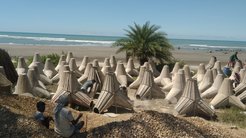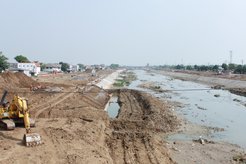Emmy Noether Group: Sand - The Future of Coastal Cities in the Indian Ocean
About | People | News | Cooperation Partners | External Website


As central component in seabed systems, port facilities, and land “reclaimed” from the sea, sand is a constitutive ingredient of urban infrastructure. It provides the basis for, and gives form to, inhabited shores by materializing territory and relations with the sea. The importance of sand for fortifying urban shorelines is growing – the construction industry and developers require sand to build “resilient” cities, while communities need it to protect settlements, vital infrastructures, and livelihoods against rising tides. Urbanization and global population growth rates are fueling a surge in demand for sand, especially in Asia and Africa. Land loss and the specter of climate change result in fortification practices that require more and more sand.

Sand has thus become the material in protecting urban property and assembling land as a resource for global investment. In light of this explosion in demand, scientists and journalist are warning that time is running out for sand. Excessive use in the context of land reclamation projects and construction not only depletes resources but also causes serious ecological damage by interfering with coastal sedimentation, clouding seawater, and disrupting ecosystems. Despite this trend, little is known about the urban metabolisms, social practices, and political formulations that rely on sand, not just in the Indian Ocean but in the Mediterranean or Pacific as well.

A focus on sand opens up creative possibilities to study the urban environment beyond a limited perspective on capital flows and governance. It can reveal unseen techniques, social arrangements, and types of infrastructures, which allow residents, communities, and other actors to recast coasts as lifeworlds according to patterns of seasonal variation and climate change but also material affordances and global economic shifts. Investigating the fundamental role of sand in place-making and coastal “edgework”, this project builds on previous work by Lukas Ley that investigated how coastal infrastructure is situated in and inhabits marine ecologies, and the discrete acts of maintenance it requires. By shifting the lens to sand itself – a material “thing” with infinitely flexible, destructive, and augmentative capacities – the project will not just think differently about human problems of territory, politics, ecosystem, and survival. It proposes essentially new ideas and methods for the study of emerging socionatures in the Anthropocene.
In thinking with contemporary economic and ecological conditions and the material faculties of sand, this project asks (a) how does sand organize and govern coastal protection in the Indian Ocean, and (b) how might thinking with sand inform our theories of urban nature?
To answer these questions, the group will conduct research on practices of coastal protection in four different port cities of the Indian Ocean. The project defines coastal protection as infrastructural investments aimed at preserving life and social reproduction in intertidal zones. This work is carried out by coastal communities themselves, but also by hired workers or conservationist actors. Moving with and appropriating sand are necessary adaptations to the indeterminate nature of coastal life in the Indian Ocean, where tides, currents, and winds create ever-shifting conditions for human life. Documenting projects of coastal protection will provide clues as to the unseen operations of sand in making and unmaking coastal life, while also showing how they are tied into larger structures of resource extraction and urban governance. Comparing material interventions related to sand across port cities, this project aims at revealing and rethinking forms of environmental governance in the face of land loss.
Careful on-the-ground research with individuals and communities will enable the team to understand the ways in which sand accretes and erodes in coastal landscapes. Detailed description of everyday acts, the ordinary ethics that underlie them, and the context by which they are shaped will allow us to develop an in situ understanding of human–sand relations and their role in (un)making urban ecologies. The team will conduct ethnographic research at selected sites of coastal protection (settlements, anti-flooding projects, beaches, mangrove plantations, etc.), using a mix of qualitative research methods to produce fine-grained and comparable data. Research methods will include participant observation, interviews, participatory mapping, and other visualization tools (photography, sketches). In addition, the team will collect planning documents and assemble archival and press material to reconstruct the sociotechnical genealogies and conditions of human interaction with sand in the context of coastal management. Furthermore, each study will collect aerial and/or satellite images of sites reconfigured by sand, such as shorelines, beaches or cityscapes, to visualize shifting sand deposits and uses.





